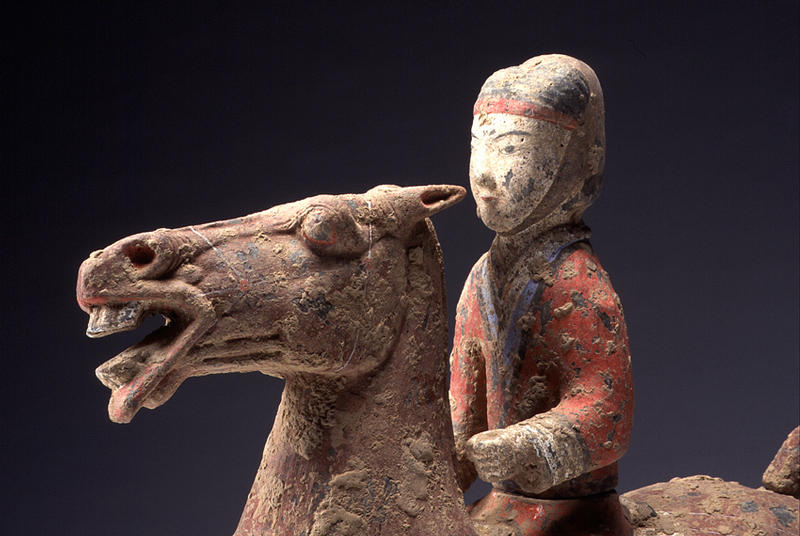Tomb Figure: Horse
- China
- China, Western Han period
- 206 B.C. - A.D. 9
- ceramic and pigments
- H-59.5 D-49 W-18.3
Catalogue Entry
Although China first took the idea of an armed cavalry from nomads living on its northern borders during the Warring States period, China itself did not possess a superior breed of horse until the Western Han dynasty, when the fabled "celestial horses" were procured from the Wusun, a pastoral people living in the region of Ferghana.1 These tall, fast animals were considered far superior to China's indigenous breed with its short legs, thick bodies, and broad necks. Indeed, the new "blood-sweating" horses became essential in China's continuous warfare against the northern nomadic confederacy, and their unique physical characteristics are illustrated in this tomb figure of a cavalryman and the bronze horse in the next entry (cat. no. 117).
This dynamic-looking ceramic horse, with its broad, powerful chest, straight neck, protruding eyes, and open mouth, is very different from the placid, sturdy images found in the tomb pits of the previous dynasty's emperor, Qin Shihuangdi. On this horse, an erect soldier, dressed in several overlapping tunics and a pair of straight pants, is seated upon a saddle. Both of the warrior's hands have openings: his left hand is raised as if he were holding the reins; his lower right hand is fashioned to hold a weapon. Horse and rider were both created out of a series of molded pieces. Some were attached before firing, such as the saddle and lower portion of the soldier's body; others were added after firing, such as the upper portion of the warrior's body and the horse's tail. Horse fittings have been painted onto the body of the horse in black, white and red pigments. Red also colors the horse's lips, nostrils, and inner ears. The rider's facial features and hair are painted in black, his cap colored brown, and his headband and tunic painted red. A violet lapel trim complements his tunic, which also features a black painted belt.
The Shumei warrior-and-horse tomb figure is stylistically similar to those found in the tombs at Yangjiawan, Xianyang, Shaanxi province, in 1965, which are believed to have belonged to a Western Han prime minister Zhou Bo and his son Zhou Yafu.2 Within these tombs, the ceramic, painted cavalry acted as a rear guard behind the foot soldiers. The Shumei and Yangjiawan cavalry tomb figures confirm the importance of the cavalry and reflect the type of military uniforms and horse fittings popular during the Western Han dynasty.
JMS
1. Warfare during the early Warring States period was dominated by chariots. Later the use of chariots, which had always been difficult to maneuver, diminished as the advantages of a more flexible infantry were realized. By the end of the fourth century B.C., the Chinese had learned from the Xiongnu the advantages of mounted archers to supplement the infantry. For more information see Bodde 1986, pp. 24-25.
2. These tombs date from the reigns of emperors Wendi (179-157 B.C.) and Jingdi (156-141 B.C.). Also see Wenwu 1966.3, pp. 1-5; Wenwu 1977.10, pp. 10-12; Hong Kong Urban Council, 1993, p. 52.
3. Wang 1987, p. 47.

